Olympus Zuiko Digital ED 50-200mm 1:2.8-3.5 SWD
Olympus Zuiko Digital ED 50-200mm 1:2.8-3.5 SWD: Performance
Shooting at 50mm, at maximum aperture, sharpness across the frame is already very good, and remarkably consistent from edge to edge. Peak quality for this focal length is achieved at f/4, where the quality approaches excellent levels across the frame.Zooming to 100mm results in a slight reduction in resolution recorded at maximum aperture, but still the quality is very good across the frame here. Peak quality for this focal length is achieved at f/5.6, where again, the sharpness approaches excellent levels across the frame.
Finally at 200mm, sharpness in the centre of the image area is good at maximum aperture, and fairly good towards the edges. Stopping the lens down to f/5.6 results in very good sharpness in the centre and good sharpness towards the edges of the frame.
| Resolution at 50mm | Resolution at 100mm |
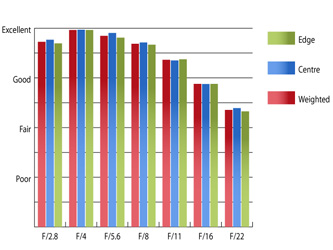 | 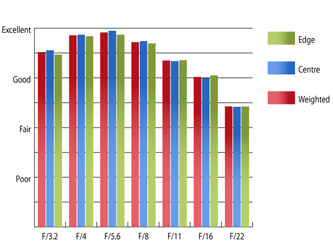 |
| Resolution at 200mm | How to read our graphs The blue column represents readings from the centre of the picture frame at the various apertures and the green is from the edges. Averaging them out gives the red weighted column. The scale on the left side is an indication of actual image resolution. The taller the column, the better the lens performance. Simple. For this review, the lens was tested on an Olympus E-3 using Imatest. |
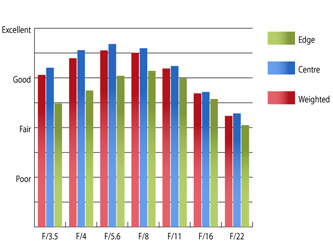 |
Chromatic aberrations are remarkably well controlled, especially as this is an area where super-telephoto lenses like this generally suffer. Imatest was only able to detect fringing of 0.3 pixel widths at 400mm and f/22, which is the worst you can expect to see. This level should be invisible in normal images, even at very large print sizes and from very harsh crops.
| Chromatic Aberrations at 50mm | Chromatic Aberrations at 100mm |
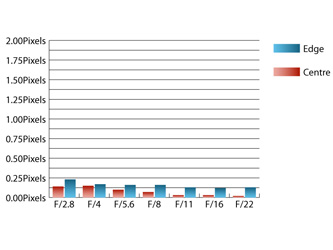 | 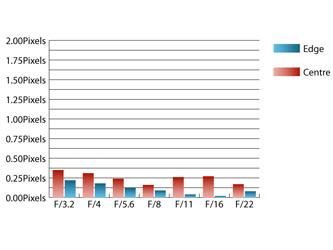 |
| Chromatic Aberrations at 200mm | How to read our chartsChromatic aberration is the lens' inability to focus on the sensor or film all colours of visible light at the same point. Severe chromatic aberration gives a noticeable fringing or a halo effect around sharp edges within the picture. It can be cured in software.Apochromatic lenses have special lens elements (aspheric, extra-low dispersion etc) to minimize the problem, hence they usually cost more. For this review, the lens was tested on an Olympus E3 using Imatest. |
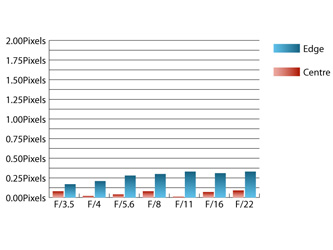 |
Levels of distortion are mild at either end of the zoom range. At 500 Imatest detected barrelling of 1.19% and 0.712% pincushion distortion at 200mm. The distortion pattern is uniform across the frame at both ends of the range, which should make it simple to correct in image editing software afterwards.
A deep circular hood comes supplied with the lens which can be reversed for storage. Light sources outside of the frame can cause flare and loss of contrast so it is a good idea to use the hood wherever possible. Shooting into the light also causes a slight loss of contrast.
 |  | |
| Maximum magnification – ISO100, 1/125, f/8, 200mm | Wildlife – ISO200, 1/320, f/4, 200mm | |
 |  | |
| Wide-angle – ISO100, 1/250, f/3.5, 50mm | Bokeh – ISO100, 1/200, f/4, 200mm |
Add your message
Login required
Please login here or if you've not registered, you can register here. Registering is safe, quick and free.
Please login here or if you've not registered, you can register here. Registering is safe, quick and free.
photodo Stats
1102 lenses
428 MTF tests
74 in-depth photodo reviews
100+ users join each day
Help the lens community by reviewing or rating a lens today via our lens search
428 MTF tests
74 in-depth photodo reviews
100+ users join each day
Help the lens community by reviewing or rating a lens today via our lens search
Latest Lens Reviews
- Chinon 28mm f/2.8 Vintage Lens Review
- Canon EF 70-200mm f/4L IS II USM Lens Review
- Samyang AF 85mm f/1.4 EF Review
- Sigma 70mm f/2.8 DG Macro Art Review
- Samyang AF 24mm f/2.8 FE Review
- Meike 50mm f/1.7 Review
- Tamron 70-210mm f/4 Di VC USD Review
- Lensbaby Burnside 35mm f/2.8 Review
- Asahi Super Takumar 50mm f/1.4 Review
- Asahi Super-Multi-Coated Takumar 135mm f/3.5 Review
